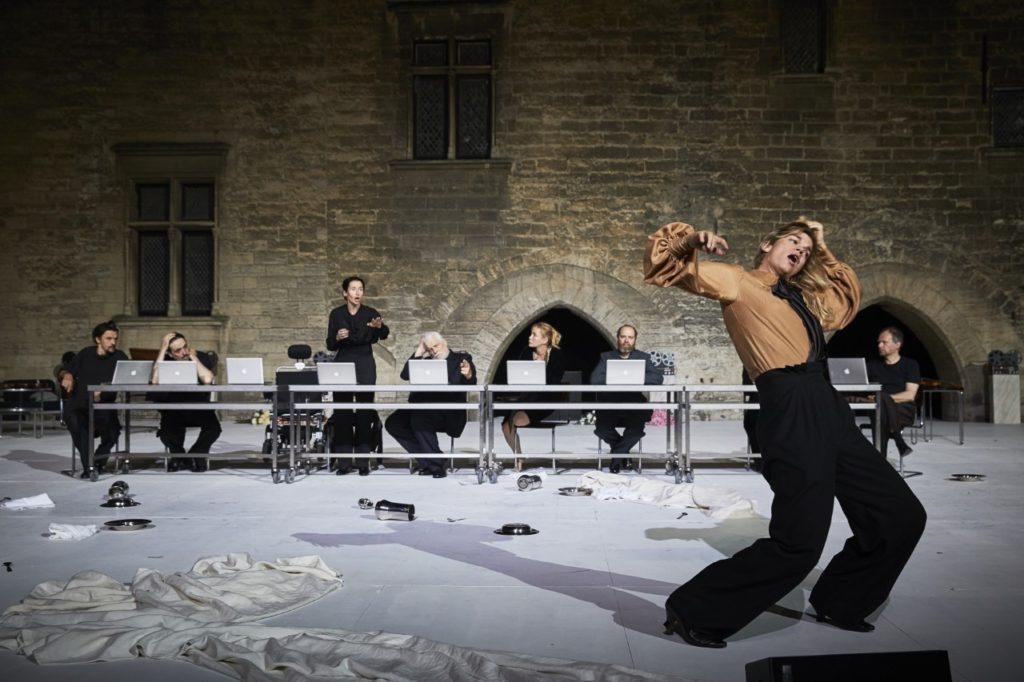Avignon 2019: Architecture: between history and philosophy

Walter Benjamin once said that storytelling is a form of ¨artizan communication¨, a narrative positioned between an act of historiography and an act of philosophy (1970).
Pascal Rambert’s production Architecture is an example of such theatrical storytelling. Not your typical history play, with historical figures easy to recognize and identify, Architecture proposes a troubled and urgent view on the 20th century European history as reflected in the story of one fictional family. In its themes and conflicts, the play dialogues with the masterpieces of the European theatre and the philosophy of Wittgenstein, to who language was the greatest tool of communication but also of deception.
An echoing of Brecht’s epic, Mother Courage, Architecture begins in the modernist Vienna of Arthur Schnitzler’s plays, with Weber family preparing for its European voyage. The action spins over the milestones of European history, to which the family loses its members and dreams. It closes with the events of Anschluss, when in March 1938 Austria has become a part of the Nazi Germany.
In the centre of this family saga is Jacques Weber (played by Jacques Weber), the great Austro-Hungarian architect who erected beautiful buildings all over Europe. A family patriarch, Jacques firmly believes in the moral values of making art, the values – he trusts – now lost on his own children: his two daughters, Anne Brochet and Emmanuelle Béart, married to Laurent Poitrenaux and Arthur Nauzyciel, and two sons, Denis Podalydès and Stanislas Nordey. Weber’s children, like their father, have dedicated their lives to arts and philosophy, to thought and beauty, seeking ways to make humanity better. However, Jacques, a worshipper of classical forms, finds himself in an ideological standstill with his son Stan (Stanislas Nordey), a philosopher of Wittgenstein and Benjamin’s kind, and his other son Denis (Denis Podalydès), a composer of atonal music, inspired by Arnold Schönberg. Soon, however, they all will discover that their philosophical disagreements will lose their importance and perish in the vortex of history.
As Rambert seeks this story’s ending, he breaks the dramatic illusion. The final scene presents a welcome change in pace and style, a kind of dance macabre with the characters taking us into the sacred chambers of theatre making. Acting like Pirandello’s personages, who searched for their author and the meaning of their play, the actors of Architecture enact the death of each of their characters, while others narrate their physical actions. This way, the production creates the effect of distancing – a la Brecht; it turns its characters from the active players of history into its chroniclers.
This impression is repeated in the stage design. Unfolding in the vast space of La Cour d’honneur du palais des papes, Architecture pays homage to its theatrical memories. What began in the clearly Chekhovian setting of white furniture and dress, turns at the end into the gloomy black and brown shapes of the Bauhaus style. There is also a live horse brought onto the stage in memoriam of Patrice Chéreau.
The final image is specifically striking: Vivian, a 13-year-old daughter of Denis and Audrey, comes on stage last minute. She is surprised with what she sees – the voice of the new generation who is about to start making its own history today, Vivian is left with the responsibility to think about the future, in the times, as she says, when people are not expected to think. In its abrupt ending, Architecture does not leave space for hope. Rather, it wishes to remind us that theatre has a responsibility to examine history in order to diagnose the maladies of its own time. The play also serves as a warning sign. The fault of the Weber’s family, it demonstrates, was in their loss of language that made them unable to communicate these values and thus immobile and disintegrated in the face of the atrocities. Today, the play seems to argue, we – the artists and the intellectuals – find ourselves in a similar position. Unable to articulate and convey the dangers of the new history that the reign of populism and nationalism can bring, Architecture reveals the old Europe standing powerless in the face of its rapidly changing identity and ideology, desperately seeking answers to these changes.
It is not surprising therefore that Architecture was chosen to open the 73rd edition of the Avignon Festival, dedicated this year to the questions of history, memory, solitude and reconciliation, migration and its consequences for the collective consciousness of the French people and Europeans in general.
Created for and with a close team of collaborators, Rambert worked with most of the actors before and wrote his play naming its characters after his actors, Architecture asks: what role must the artist play in today’s world marked by rising nationalist and populist sentiments, antisemitism, xenophobia and fascism?
ARCHITECTURE
Text, direction, and installation Pascal Rambert
With Emmanuelle Béart, Audrey Bonnet, Anne Brochet, Marie-Sophie Ferdane, Arthur Nauzyciel, Stanislas Nordey, Denis Podalydès sociétaire of the Comédie-Française alternating with Pascal Rénéric, Laurent Poitrenaux, Jacques Weber and Bérénice Vanvincq
Co-production Festival d’Avignon, Théâtre National de Strasbourg, Théâtre national de Bretagne (Rennes), Théâtre des Bouffes du Nord (Paris), Bonlieu Scène nationale d’Annecy, Les Gémeaux Scène nationale (Sceaux), La Comédie de Clermont-Ferrand Scène nationale, le Phénix Scène nationale pôle européen de création (Valenciennes), Les Célestins Théâtre de Lyon, Emilia Romagna Teatro Fondazione (Vignola, Italie)
Festival D’Avignon, La Cour d’honneur du palais des papes; July 4 – 13, 2019
Photo – Christophe Raynaud de Lage